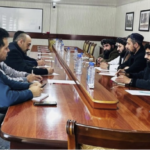Dozens of calligraphy works by teachers and students of the Ustad Kamāl ud-Dīn Behzād Vocational Institute have been displayed in an exhibition in Herat City.
These artists criticize the lack of attention from the public and the government toward the art.
Abdul Qayoom Faizi, head of the Ustad Kamāl ud-Dīn Behzād Vocational Institute of Arts, said: “About 61 of our calligraphy works are on display here, showcasing Nastaliq, Broken Nastaliq, Neyaish font, Naskh, and the Kufic script of the first century.”
Some calligraphers in Herat say that for the better growth of calligraphy, support from the government and the public is essential.
Shamsuddin Noorizada, a calligraphy teacher, said: “Artists have had less government support. They haven’t been supported as they should be. This Islamic art must receive backing.”
One of the demands of Herat’s calligraphers is the opportunity to participate in international exhibitions.
Faramarz Sarwari, a calligraphy teacher, told TOLOnews: “The government should purchase their works and provide opportunities for international exhibitions for calligraphers and other artists.”
According to them, their valuable calligraphy works can represent Afghan art on the global stage.
Nahik Falah, a cultural expert, said: “They should exhibit the foundational scripts, as Herat has been the shining stage for these arts. UNESCO should be invited to showcase Herat as the birthplace of art.”
Meanwhile, the Turkish TIKA office in Herat has recently renovated the Ustad Kamāl ud-Dīn Behzād Vocational Institute of Arts.
Arafat Deniz, the head of the Turkish TIKA office in Herat, said: “Our main focus in this restoration has been the exhibition hall, the sports section, the library, and the mosque.”
Herat is the birthplace of many scripts like Nastaliq, Broken Nastaliq, Naskh, and Kufic. Calligraphy is one of Herat’s ancient and valuable arts.
These scripts were created over different historical periods and were particularly developed during the Timurid golden age.











